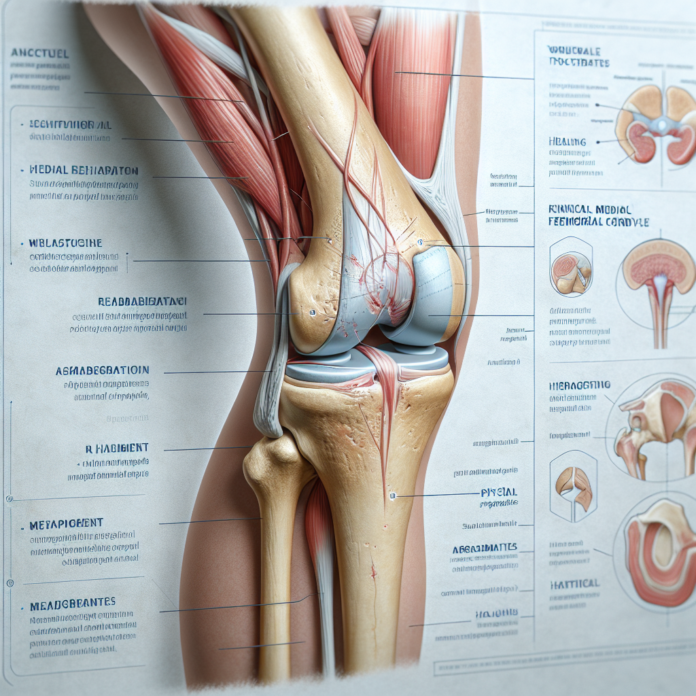In the realm of orthopedic injuries, a fracture of the medial femoral condyle stands out as an uncommon yet intricate condition that requires careful attention, particularly among adults. While it is more frequently observed in children due to their developing skeletal structure, adults facing this injury must navigate a unique path to recovery. This blog, inspired by Dr. David Guyer’s insightful video, delves into the nuances of medial femoral condyle fractures, shedding light on when surgical intervention is necessary and what the recovery process entails. As a triple board-certified orthopedic surgeon and sports medicine specialist, Dr. Guyer combines his expertise with regenerative medicine to guide individuals toward optimal healing and performance. Join us as we explore the complexities of this injury, drawing from real-life inquiries to provide clarity and education for those facing this challenging journey.
The Nature of Medial Femoral Condyle Fractures
At its core, a fracture of the medial femoral condyle involves the ends of the femur, where the femoral condyles meet the knee joint. These condyles play a crucial role in knee movement and stability, acting as pivotal components of the knee’s intricate structure. The medial femoral condyle is specifically located on the inner side of the knee, closest to the body’s midline. When fractured, it typically presents in a shearing pattern, an injury that occurs more readily in children due to the relative weakness of their bones compared to ligaments and tendons.
In adults, however, it’s a less common occurrence, often requiring a significant traumatic force. The focus in adults tends to be more on ligament injuries, such as medial collateral ligament (MCL) damage, as the bone is generally stronger and more resilient in comparison. Understanding the mechanics of this fracture is crucial, as the alignment during healing is paramount to prevent future complications, such as arthritis.
The Importance of Proper Alignment
The importance of proper alignment cannot be overstated. When the fracture heals, if the bones are not aligned perfectly, there can be a step-off in the articular cartilage. This misalignment creates an uneven surface, potentially causing wear and tear on the cartilage, which leads to degenerative changes and arthritis over time. For this reason, surgical intervention may be necessary to adequately align the bone fragments, restoring the joint surface for optimal function.
Surgical Intervention and Recovery
Surgery for medial femoral condyle fractures usually involves a plate and screw configuration to stabilize the fracture and ensure proper healing. This technique securely holds the bone pieces in place, allowing them the stability needed to heal effectively. The decision to proceed with surgery is dependent on the nature of the injury and its displacement. Minimally displaced fractures may sometimes be managed non-surgically, but consultation with an orthopedic surgeon is essential for determining the best course of action.
Recovery from surgery is a carefully graded process. Patients are often required to limit weight-bearing activities for extended periods, typically ranging from 6 to 12 weeks. This restriction is crucial to prevent displacement of the fracture, which could impair healing or necessitate additional surgical intervention. The healing of a fractured medial femoral condyle generally takes about three to four months. However, this can vary based on the individual’s overall health, the specifics of the fracture, and the surgical outcome.
Return to Daily Activities
The timeline for starting weight-bearing activities also varies among patients, often occurring towards the end of the initial healing phase. Supervised physical therapy is usually recommended to gradually restore mobility, strength, and function in the affected leg. Physical therapy plays an instrumental role in a patient’s recovery, helping improve joint mobility and muscle strength, which facilitates the transition back to regular activities, including work.
Returning to work is another aspect that hinges heavily on the nature of the patient’s occupation. Individuals with desk jobs or roles that require minimal physical demand may resume work relatively quickly, often within weeks of surgery, provided they have access to appropriate mobility aids. Conversely, those whose occupations involve significant physical activity may need more time, as the need to navigate workplace movements with crutches or a walker early in the recovery process can be challenging.
Conclusion
It’s important to note that every recovery journey is unique, and it’s vital for patients to follow the guidance and recommendations of their healthcare provider closely. Through medical consultations, patients can explore alternative treatment options beyond surgery, such as regenerative medicine approaches, which Dr. Guyer specializes in, offering potential avenues for healing without more invasive interventions.
Ultimately, a fracture of the medial femoral condyle is a formidable challenge, but with the appropriate surgical technique, rehabilitation, and possibly alternative treatments, individuals can aim for a successful recovery. Staying informed, adhering to medical advice, and remaining patient throughout the healing process will help individuals achieve the best possible outcome, allowing them to return to their daily activities with renewed strength and vitality.
For those with orthopedic concerns or in need of a personalized approach to their treatment, seeking a consultation with a specialist like Dr. David Guyer could be a beneficial step in their recovery journey. Through his expertise, patients can explore a variety of treatment options tailored to their specific needs, paving the way for enhanced recovery and long-term joint health.
Discover the complexities of medial femoral condyle fractures in Dr. Guyer’s video, from surgery needs to recovery tips, ensuring optimal healing and joint health.
